What to Pack for a Hike in the Pacific Northwest and Alaska
Last Updated on April 21, 2025
This post is all about what to pack for a hike in the Pacific Northwest and Alaska. As I talked about in my post about hiking for absolute beginners, you don’t need a lot of gear to get started with hiking. You may not bring the exact same things I do. Different people have different things that they consider essential or not as important, and what you need evolves over time. There are quite a few items that I pack for a hike now that I didn’t for many years, or only recently started bringing with me. Head to this post to for what I wear on hikes around the Pacific Northwest and Alaska all year long.
I do quite a bit of solo hiking and hiking in remote areas where help is far away. I carry the 10 essentials, which are designed to help you survive a night outside on your own if you have to, as well as to get through the day safely. Luckily, I’ve never had to spend an unexpected night out alone, but I have several times been caught in the dark and needed my headlamp! I’ve also used my first aid kit quite a few times.
The things I always pack for a hike live in my backpack so I never have to decide if I’m bringing them or not, they’re just always there. The only things I have to add to get out the door are whatever additional clothes are needed for that outing, my food, filling my water and the appropriate map. This helps me get out and hike more often! There are a few extra items I sometimes bring that are noted below.
I’ve organized this by what I pack for a hike in both summer and winter including a description of why I bring that item. During spring and fall I do a bit more packing and unpacking since what I need is slightly less predictable (for example I might bring sunscreen and the warm hat).
Generally I’m considering summer to be June through September and winter to be November through March. In April, May and October I bring some combination of the summer and winter things. It’s important to note that the Pacific Northwest and Alaska have many different climates, from wet and cool (or cold) in Western Washington, Coastal British Columbia and Southeast Alaska, to hot and dry summers in the Inland Northwest, Interior British Columbia, the Yukon and Interior Alaska. That said, it’s possible for it to be cold and rainy anywhere in Alaska in the summer, or anywhere in the Coastal Pacific Northwest. Interior climates can also be extremely cold in the winter.
Bottom line: Use this as a guide, but always check the weather forecast for the area you will be hiking in and be prepared.
This post contains affiliate links, which means if you make a purchase I may receive a small commission at no additional cost to you. As an Amazon Associate, I earn from qualifying purchases.
What I Pack for a Hike in Summer
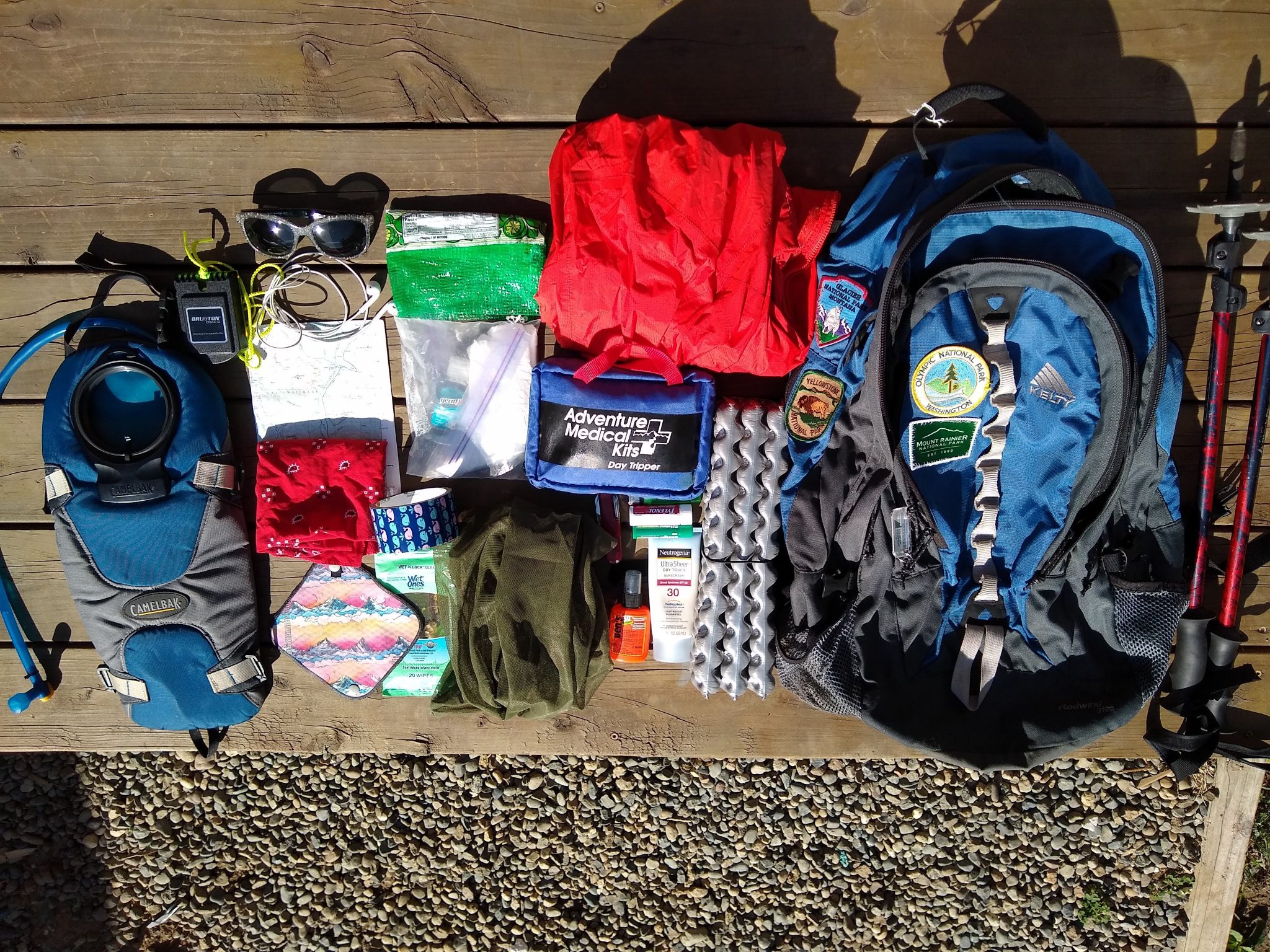
Listen to this on the Washington State Hiking Podcast instead
Backpack
Here’s a secret – you can pack for a hike in LITERALLY ANY BACKPACK YOU ALREADY HAVE! There’s no need to get a special one just for hiking especially getting started. The backpack I have I bought for $25 at an REI garage sale more than 15 years ago and I love it. You can start with whatever you have, and if you don’t have one, try getting fitted at an outdoor store and try on a variety of options.
Rainjacket
I keep it in my pack and then it’s there in case of a sudden shower and it is also very effective bug protection if needed! There are plenty of days with showers in the mountains even when it’s sunny and hot in town. I prefer a Goretex rainjacket because they are waterproof and super durable. I recommend getting one size bigger than you normally would to accommodate warm layers underneath.
Extra Layer
Yes, even on hot days I always bring one warmer layer than I think I will wear. Quite often I end up wearing it at some point during the day!
Trekking Poles
I find trekking poles to be so helpful especially on steep climbs and descents. They also help keep my hands from swelling which is a bonus. Many people with knee pain find them lifesavers (or rather knee savers). They are certainly not necessary, and I’ve done many hikes without them, but I am a big fan. I recommend the kind of trekking poles that have locking connections when you expand and contract them instead of the twist kind, since they wear out. I like these poles on Amazon.
Water
It’s important to bring water! You can bring it in any water bottle you have (no need for anything special). If you do a lot of hiking, I recommend a water bladder. I drink a ton of water and it’s so nice to be able to drink it without getting out a water bottle. This is completely unnecessary but it makes a big difference for me. Mine has lasted for 10 years and counting! There are a variety of sizes, I have the 100oz one. Find one here on Amazon.
For a waterbottle instead of a bladder (better for winter), I love the metal insulated kind that don’t freeze like the water bladder can. On a really hot day in summer you can keep ice in one of these for hours! I love the the Hydroflask one with a straw, shop for it here on Amazon. Both of them perform really well keeping hot drinks hot and cold drinks (even ice) cold for many hours.
Food
Make sure to bring food, and more than you need! Read about my favorite hiking snacks here. I’ve found there’s nothing better than a mesh bag from Trader Joe’s (the kind lemons and limes come in) for keeping all my food together (no smooshed sandwich forgotten in the bottom of the pack!).
First Aid Kit
I have a few additions in my first aid kit, which include an emergency blanket (which weighs nearly nothing) and a votive candle which is a very effective fire starter in an emergency, especially if it’s wet. Other than that it’s a standard first aid kit (get it here on Amazon). It’s not super helpful to have this without knowing how to use it! Keeping first aid and CPR up to date is a good practice for anyone, and it’s useful on the trail as well. If you can commit more time, Mountaineering Oriented First Aid takes it a step farther and prepares you for emergencies when help is far away. I also bring a small roll of duct tape, which is useful for lots of things.
Sun Protection
Sunscreen, Lip balm and Sunglasses are all important for sun protection! I also like to wear a hat. Long pants and light long sleeved shirts can also be really effective at sun protection and double as bug protection.
Headlamp
This is important! I have several times been caught out in the dark and used my headlamp to get to the car. This turns a potentially dangerous situation into a fun adventure. It lives in my pack. You can take any flashlight you have, but a headlamp is light and convenient (also for power outages at home). I like this one that has a red light and a rechargeable batter – get it here on Amazon.
Knife
I use a standard small swiss army knife and it lives in my pack. It’s useful for a variety of little things like repairs or opening packaging or cutting food. It’s really critical for backpacking, but I find it’s helpful on dayhikes too.
Map
Yes, I carry a paper map of where I’m going. I really like to follow along on the map where I am on the trail. This is interesting data but it can also help me make good decisions about when to turn around and if I’m going the wrong way. I don’t like counting on my phone only, especially if I’m away from a cell phone signal.
I also carry a Garmin inreach Mini anytime I’m going to be away from a cell phone signal. More about that further down in this article.
Compass
I rarely use this, but it’s inexpensive and light and it is definitely useful if you get turned around about where you are. Both the compass and the map aren’t that useful if you don’t know how to read them! I highly recommend the mountaineers navigation course that teaches you how. There are other places to take classes as well but that’s one that I’ve personally done and it was excellent.
You can also use a GPS but again, make sure you know how to use it and that you can use it offline if you’re hiking away from a cell phone signal.
Lighter
This is for lighting fires in case of emergency, and a cheap lighter works great! You could also bring waterproof matches instead. It weighs nothing and lives in my pack.
Phone and Headphones
You take your smartphone everywhere else, why not the trail? To preserve the battery (especially where there isn’t a signal anyway), put it in airplane mode. I map my route, use it as a camera and listen to music.
I listen to music when I hike solo, at least a good portion of the time. Even with others, if it’s a really hard hike, sometimes I’ll put them in for encouragement during tough parts of a climb. Some people think you should leave all technology at home and listen to nature, and while I love listening to nature I also love listening to music in nature. If you like listening to music like I do, by all means bring the headphones!
Sitpad
This is not necessary but once you try it you will LOVE IT. It’s especially great if there’s snow on the ground or it’s wet, but anytime it provides a comfortable and insulating seat. You canalso use it as a splint in a pinch or to have an injured person sit on to help them stay warm. Comfy AND you can use it as part of your first aid kit! The inflatable kind is comfier and packs smaller and the closed cell pad lasts longer and is less expensive.
Bug Protection
Read more here about how I protect myself from mosquitoes on the trail (7 years in Alaska here!). I recommend bringing bug spray that is 30% deet or more. I also highly recommend long pants and bringing along a lightweight button up shirt (I usually leave it unbuttoned over a tank top). If bugs are really intense, rain gear is great bug protection, but you will get really hot in summer if you’re moving in rain gear.
Toilet Paper or Kula Cloth, Hand Sanitizer and Wet wipes
Packing out toilet paper is extremely important! Do NOT leave it on the trail. Bring along a ziploc for this purpose. If you don’t want to pack out toiler paper, use a Kula Cloth instead! Don’t knock it till you try it. It’s AWESOME (for pee only).
If you need to poop, you can bury it in a hole and pack out the toilet paper, or you can put it in a ziploc inside another ziploc. The ziplocs and wet wipes are important here! But pack it all out.
Speaking of wet wipes, they are so useful for all kinds of things, cleaning hands, a refreshing facewipe at lunch, etc. Indispensible!
Related: Complete Guide to hiking in the rain
What I Pack for a Hike in Winter
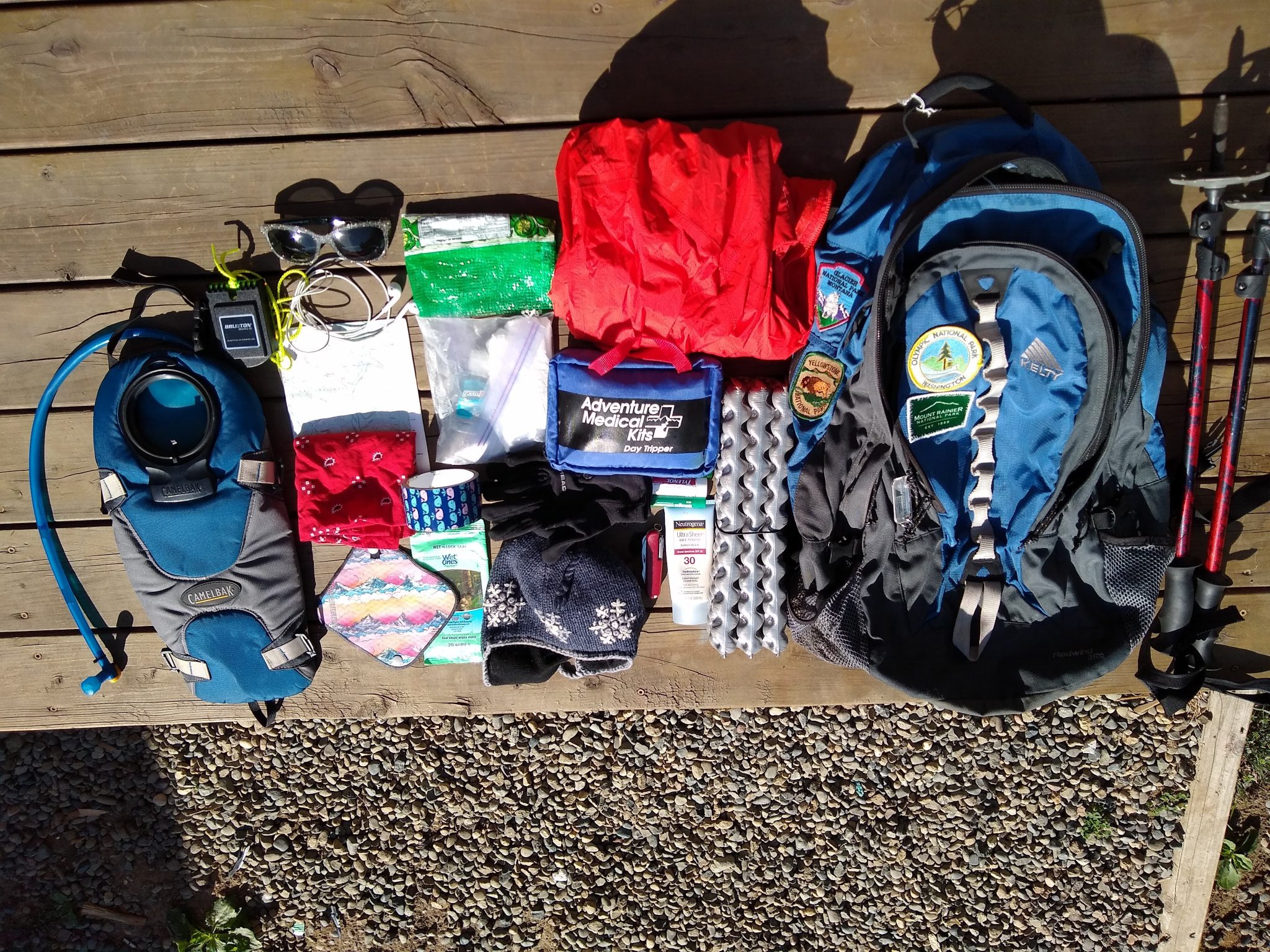
Here I’m talking about going for a hike in winter, in my post about starting snowshoeing I talk about gear for that (which isn’t all that different, actually!). What I pack for a hike isn’t that different in the winter, although what I wear is usually different and I make sure to carry more food that I would in the summer. What’s different for what I pack for a hike in winter:
Listen to this on the Washington State Hiking Podcast instead
- I take out the bug head net and bug spray
- I take out the sunscreen from October or November through February-you still need to be careful about the sun even during our rainy winters (especially in spring if you’re on snow), but I generally put it on a home if I need it before leaving and don’t carry it with me. Starting in March, even if it’s cold the sun gets intense!
- I bring an EXTRA very warm layer (coat, fleece or sweater) in addition to what I think I will wear while hiking
- A warm hat that covers my ears lives in the pack all winter
- A pair of gloves lives in the pack all winter
- Microspikes (get them here on Amazon) that you can attach to your shoes. They’re basically like studded snow tires for your shoes and if it’s icy they are awesome. I use them most often in the fall in high country places that are icy in the mornings as well as in the spring when I might be on hard, crusty and icy snow. You can get some that are really expensive and metal, but that really isn’t necessary, as long as they have some type of metal spike they make a big difference. You can stretch them over whatever shoes you’re wearing.
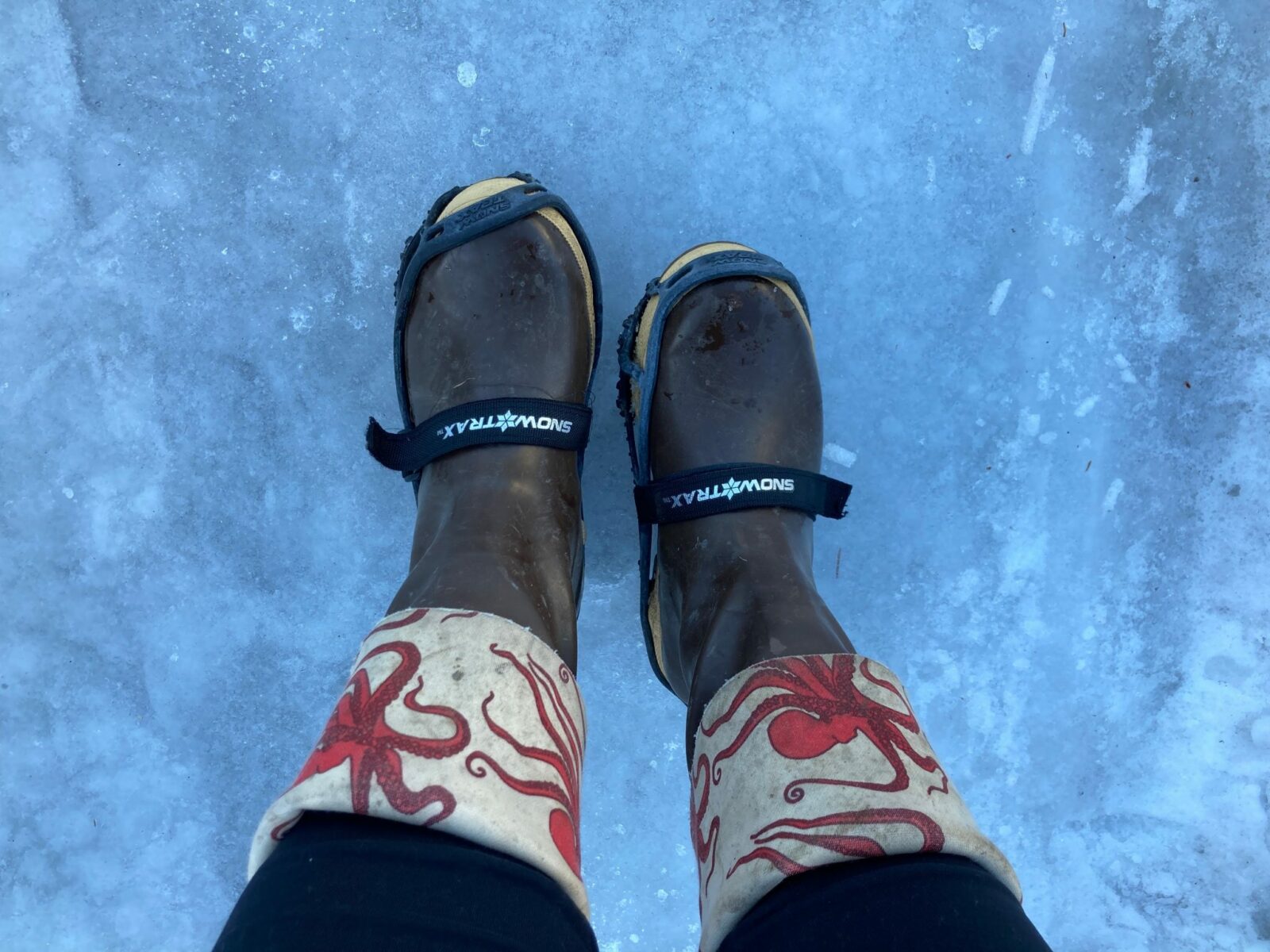
Other things I sometimes bring depending on the circumstances
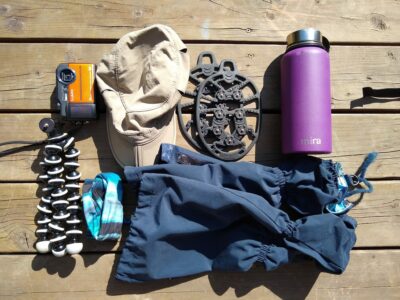
There are a few other things that I sometimes bring day hiking, but they don’t regularly live in the pack, I add them if it makes sense on that particular day.
- Small tripod: this is an excellent way to do even more with your smartphone! It’s tiny and super helpful if you take a lot of photos on the trail.
- Back up phone battery: I find this super helpful and consider it an important piece of safety equipment (especially now that I have the Garmin Inreach Mini – see below for more)
- Gaiters: Gaiters are handy if there’s snow involved or if you’re going to be going through a lot of wet brush. They keep water out of your boots and lower legs. They aren’t necessary, but they can make life a lot more pleasant, especially in the winter! Get them here on Amazon.
- Bearspray: I carry this when I’m by myself, in case of bad people and because when you’re by yourself you don’t alert animals as much to your presence. I don’t think most people carry this in Washington, but I do just in case if I’m by myself (I usually don’t when I’m with other people). In Alaska and other places with more bears and especially problem bears, carrying it is imperative. Keep in mind that you can’t take it on airplanes, so you have to buy it where you’re going if a plane is involved. Get it here on Amazon.
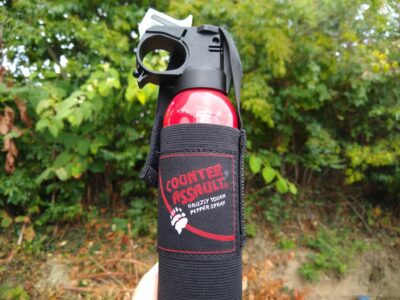
- I do a lot of hiking by myself, so I decided to invest in a Garmin Inreach Mini. This is a small GPS and satellite communicator that I highly recommend, especially for anyone who hikes alone. It requires a monthly subscription in addition to the cost of the device and it allows you to send short texts through satellite when you don’t have a cell phone signal. You can also signal search and rescue if you get in trouble. It has a bit of a learning curve but once I mastered it I’ve been very happy to have it. Get one here on Amazon.









